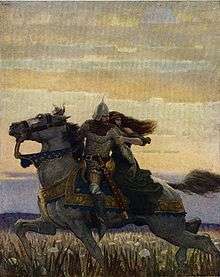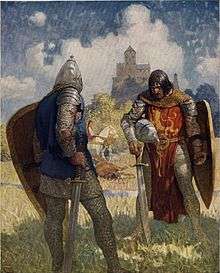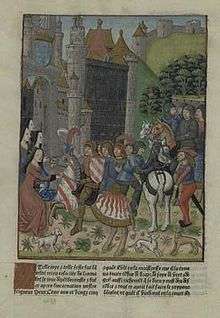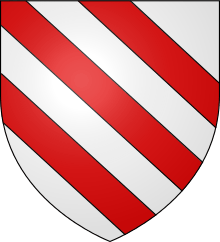Lancelot
Sir Lancelot du Lac (meaning Lancelot of the lake, baptised as Galahad) was one of the Knights of the Round Table in the Arthurian legend. He typically features as King Arthur's greatest companion, the lord of Joyous Gard and the greatest swordsman and jouster of the age — until his adultery with Queen Guinevere is discovered, causing a civil war exploited by Mordred which brings about the end of Arthur's kingdom.
His first appearance as a main character is in Chrétien de Troyes' Le Chevalier de la Charette ("The Knight of the Cart"), written in the 12th century, where his exploits are recounted in the section known as the Prose Lancelot. Often with conflicting background stories and chains of events.
Origins
Pre-Romance origins

Scholar Roger Sherman Loomis suggested that Lancelot is related to either the character Llenlleog the Irishman from Culhwch and Olwen (which associates him with the "headland of Gan(i)on") or the Welsh hero Llwch Llawwynnauc (probably a version of the euhemerized Irish deity Lugh Lonbemnech), possibly via a now-forgotten epithet like "Lamhcalad".[1][2][3] Traditional scholars thought that they are the same figure due to the fact that their names are similar and that they both wield a sword and fight for a cauldron in Preiddeu Annwn and Culhwch.[3]
Modern scholars are less certain. One suggestion has been that the name may have been an invention by Chretien de Troyes, given the manuscript evidence of L'Ancelot, since "ancelot" means "servant." Another suggestion is that the name may have been derived from Geoffrey of Monmouth's Anguselaus. However, one scholar has suggested that Lancelot may be a variant of the name "Lancelin".[4] Lancelot or Lancelin may have instead been the hero of an independent folk-tale which had contact with and was ultimately absorbed into the Arthurian tradition.
The theft of an infant by a water-fairy, the appearance of the hero at a tournament on three consecutive days in three different disguises, and the rescue of a queen or princess from an Other-World prison are all features of a well-known and widespread tale, variants of which are found in almost every land and numerous examples of which have been collected by Theodore Hersart de la Villemarqué in his Barzaz Breiz, by Emmanuel Cosquin in his Contes Lorrains, and by J. F. Campbell in his Tales of the West Highlands.
Earliest appearance
The character Lancelot is first introduced by writer Chrétien de Troyes in the 12th century. In Chrétien's earliest known work Erec and Enide, the name Lancelot appears as third on a list of knights at King Arthur's court. The fact that Lancelot's name follows Gawain and Erec indicates the presumed importance of the knight at court, even though he did not figure prominently in Chrétien's tale. Lancelot reappears in Chrétien's Cligès. Here, Lancelot takes a more important role as one of the knights that Cligès must overcome in his quest.[5]

It is not until Chrétien's Le Chevalier de la Charrette, however, that Lancelot becomes the protagonist. In this text, he is presented as the most formidable knight at King Arthur's court. His adulterous relationship with the Queen is also introduced in this text. According to Pamela Raabe, Lancelot is portrayed in Chrétien de Troyes’ work as the bravest of knights and one whom everyone is forced to describe as uniquely perfect. His deeds are recounted for their uniqueness, not only among living knights but of all men who have ever lived. The problem is that critics have been unable to agree on how to reconcile his perfect “saintliness” with his obvious adultery with King Arthur’s Guinevere. How can the lovers’ consummation be considered a “saintly affair” when it is also adultery? And that adultery is against King Arthur, to whom all knights owe selfless respect, according to Arthurian politics and William Bowman Piper.[1] It is also Chrétien who first gives Lancelot the name Lancelot du Lac (“Lancelot of the Lake”)[6] which was later picked up by the Anglo-French Lancelot-Grail and then Malory.[7]
Lancelot is constantly tied to the Christianity associated with Arthurian Legend. Raabe compares Lancelot’s quest for Guinevere in “Lancelot, the Knight of the Cart” to Everyman’s quest for salvation and Christ’s quest for the human soul. This becomes intensified when he becomes the prophesied saviour of the captives of Logres. His adventure among the tombs is described in terms that suggest Christ’s “harrowing of Hell” and resurrection: he effortlessly lifts the lid off the sarcophagus, which bears an inscription foretelling his freeing of the captives.[8]
Danielle MacBain’s study of Thomas Malory’s Le Morte d'Arthur claims that Lancelot’s affair with Guinevere is often seen as parallel to that of Tristram (or Tristan) and Iseult. MacBain suggests that it is Lancelot who is ultimately identified with the tragedy of chance and human failing that is responsible for the downfall of the round table.
Lancelot was later associated with the Grail Quest, but Chrétien does not include him at all in his final romance Le conte du graal. This story introduces the Grail motif in medieval literature, and Perceval is the sole seeker of the grail in Chrétien's treatment. Lancelot's involvement in the Grail legend is first recorded in the Perlesvaus written between 1200 and 1210.[9]
Later amplifications and versions
Lancelot's character is perhaps most fully developed in the Vulgate Cycle, where he appears prominently in the third and fourth parts, known as the Prose Lancelot (or Lancelot du lac) and the Queste del Saint Graal (or The Quest for the Holy Grail) respectively. Gaston Paris argues that the Guenivere-Meleagant episode of the Prose Lancelot is an almost literal adaptation of Chrétien's poem, though the Prose Lancelot can be seen as a considerable amplification of Chrétien's tale. Chrétien treats Lancelot as if his audience were already familiar with the character's background, yet most of the exploits that are today associated with Lancelot are first mentioned here (e.g. Lancelot's parentage; Lancelot and the Grail; Lancelot, Guenivere and the fall of Camelot; etc.).
The Middle Dutch so-called Lancelot Compilation (The Hague, KB129 A 10) contains seven Arthurian romances folded into the three parts of the cycle. Lanceloet en het hert met het witte voet ("Lancelot and the hart [deer] with the white foot") is an original romance in which Lancelot fights seven lions to get the white foot from a hart (deer) which will allow him to marry a princess. The creation of a new story indicates Lancelot's widespread popularity.[10]
Birth and childhood

Lancelot (father of Galahad)[11] is the son of King Ban of Benwick (or Benoic) and Elaine.[12] While Lancelot is an infant, his father is driven from his kingdom in Britain by his enemy Claudas de la Deserte.[13] Ban and Elaine flee, carrying the child with them. As Elaine is tending to her wounded husband, Lancelot is carried off by the Lady of the Lake who raises the child in her magical kingdom. It is from this upbringing that Lancelot earns the surname du lac (English: "of the lake").
Lancelot's double-cousins Lionel and Bors, sons of King Bors of Gaunnes and Elaine of Benoic's sister Evaine, are first taken by a knight of Claudas and later spirited away to the Lady of the Lake. They become Lancelot's companions. Both Evaine and Elaine enter a nunnery. Following a vision of Lancelot and his cousins in the Lady of the Lake's garden, both queens are happy and Evaine dies.[14]
Early adventures
The Lady of the Lake sends Lancelot to King Arthur's court where he becomes a knight at the behest of Sir Gawain. Almost immediately upon his arrival, Lancelot falls in love with the Queen, and one of his very first adventures is rescuing Guinevere from Arthur's enemy Meleagant.[15] Lancelot seems to be related to a Celtic abduction tale called the aithed. In this legend, a mysterious stranger kidnaps a married woman and takes her to his home. The husband of the woman then rescues her against insurmountable odds.[16] (Note that exact timing and sequence of events varies from one source to another, and some details are only found in certain sources. For example, in Le Morte D' Arthur, the adulterous relationship is postponed for several years, and the rescue takes place after the adventures of the Sangreal.)
Early in Lancelot's career, he faces the Dolorous Guard. He sets out for adventure and comes across a castle guarded by the Copper Knight. To meet this challenge, Lancelot must battle ten knights at the first wall, ten knights at the second wall, and finally the Copper Knight himself. He defeats many more than twenty knights with the aid of his foster mother the Lady of the Lake, only to discover that the Copper Knight has fled. The townspeople lead Lancelot to a cemetery, where he finds a metal slab stating that only one knight can lift the slab and that this knight's name is written beneath the slab. Lancelot has been known till this point simply as the "White Knight"; he is able to lift it and discovers that his name, in fact, is Lancelot.[1] The name of the Dolorous Guard is changed to the Joyous Guard and becomes Lancelot's home.[1]
Lancelot plays an important role in a war between Arthur and Galehaut (also known as Galahaut). Galahaut is Arthur's enemy and poised to become the victor, but he is taken by Lancelot's battlefield performance and offers him a boon in return for the privilege of one night's company in the bivouac. Lancelot accepts and uses his boon to demand that Galahaut surrender peacefully to Arthur. Initially, Lancelot continues to serve Galahaut, but eventually Arthur invites Lancelot to become a member of the Round Table, and Galahaut as well. In spite of this happy outcome, Galahaut is the one who finally convinces Guinevere that she may return Lancelot's affection, an action that at least partially results in the fall of Camelot.[1]
Later, with the help of King Arthur, Lancelot defeats Claudas and recovers his father's kingdom, though he again decides to remain at Camelot with his cousins Sir Bors and Sir Lionel and his illegitimate half-brother Ector de Maris.[1]
Lancelot, Galahad, and the Grail

Lancelot became one of the most famous knights of the Round Table, and Elaine of Corbenic, daughter of the Fisher King, suddenly falls in love with him. She tricks him into believing that she is Queen Guinevere and he sleeps with her, and the ensuing pregnancy results in the birth of Galahad.[1][17]
Guinevere hears of the affair and is furious. She criticizes Lancelot for his behavior and banishes him. Broken by Guinevere's reaction, Lancelot goes mad and wanders the wilderness for two years until he arrives at Corbin where he is recognized by Elaine. Lancelot is shown the Holy Grail through a veil which cures his madness. Shortly after he recovers, he returns to Camelot after being found by Sir Percival and Sir Hector. They were both told to look for him by Queen Guinevere.
Upon his return to court, Lancelot takes part in the Grail Quest with Percival and Galahad, though he is only allowed a glimpse of the Grail itself because he is an adulterer and distracted by earthly honours that have come with his knightly prowess. It is instead his son Galahad who ultimately achieves the Grail to drink from, along with Lancelot's cousin Sir Bors and Sir Percival, the son of King Pellinore.[1]
Later years and death

Ultimately, Lancelot's affair with Guinevere is a destructive force[18] resulting in the death of Gawain's brothers and his two sons, the estrangement of Lancelot and Gawain, and Mordred's betrayal of King Arthur.[1] Upon hearing the news of Arthur's death, Lancelot finds that Guinevere has become a nun.[8] [19] She blames all the destruction of the Round Table upon their adulterous relationship, which is the seed of all the dismay that followed, according to Le Morte D'Arthur. She refuses to kiss Lancelot one last time, telling him to return to his lands and that he will never see her face again. Instead, Lancelot declares that, if she will take a life of penitence, then so will he. He then retires to a hermitage to live the remainder of his life in penitence, with eight of his kin joining him, including Sir Bors. Eventually, he becomes a priest, later conducting rites over the deceased body of Guinevere (who had become an abbess). As she had indicated, he never saw her face again in life. He had a dream warning him that she was dying, so he set out to visit her. But Guinevere prayed that she might die before he arrived, and so she did, half an hour before his arrival.
After the queen's death, Lancelot and his fellow knights escort her body to be interred beside King Arthur (it was in the same place that Gawain's skull was kept). Lancelot's health then begins to fail, as he is distraught for the loss of his beloved king and queen. In fact, even before this time, Le Morte D' Arthur states that he had lost a cubit of height due to his penitent fastings and prayers. Lancelot dies six weeks after the death of the queen. It is implied that he wished to be buried beside the king and queen; however, he had made a vow some time before to be buried at Joyous Gard, so he asks to be buried there so as not to break his word.
The eight knights (who had joined Lancelot in a life of penitence) return to France in order to take care of the affairs of their lands after Lancelot's death, according to Le Morte D'Arthur. Then, acting on Lancelot's death-bed request, they go to the Holy Land and fight against the Turks. There they die on Good Friday, fighting against the Moors.
Film, television, and other media
- Robert Taylor in Knights of the Round Table (1953)
- William Russell in The Adventures of Sir Lancelot (1956-1957)
- Robert Goulet in Camelot (1960)
- Cornell Wilde in Sword of Lancelot (1963)
- Franco Nero in Camelot (1967)
- Luc Simon in Lancelot du Lac (1974)
- John Cleese in Monty Python and the Holy Grail (1975)
- Nicholas Clay in Excalibur (1981)
- Richard Gere in First Knight (1995)
- Jeremy Sheffield in Merlin (1998)
- Michael Vartan in The Mists of Avalon (2001)
- Ioan Gruffudd in King Arthur (2004)
- Nancy Cartwright in The Simpsons (2004)
- Hank Azaria in Spamalot (2005)
- Phil Cornwell in King Arthur's Disasters (2005-2006)
- Thomas Cousseau in Kaamelott (2005-2009)
- Santiago Cabrera in Merlin (2008-2011)
- Jason Griffith in Sonic and the Black Knight (2009) (Lancelot's appearance is based on Shadow the Hedgehog.)
- Ryōtarō Okiayu/Kyle Herbert in Fate/Zero (2011-2012)
- Christopher Tavarez in Avalon High (2010)
- Sinqua Walls in Once Upon a Time (2012, 2015)
- Dan Stevens in Night at the Museum: Secret of the Tomb (2014)
- Matt Frewer / Jerry O'Connell in The Librarians (2014)
Notes
- 1 2 3 4 5 6 7 8 9 Sir Lancelot, Biography : Lancelot
- ↑ Bruce, Christopher W (1998). The Arthurian name dictionary. Lancelot: Routledge. p. 305. ISBN 978-0-8153-2865-0.
- 1 2 http://www.facesofarthur.org.uk/articles/guestdan13.htm
- ↑ Goulven Péron, La légende de Lancelot du Lac en Anjou, Les Cahiers du Baugeois, n°92, mars 2012, pp.55-63, ISSN 0999-6001.
- ↑ Bruce, Christopher W (1998). The Arthurian name dictionary. Lancelot: Routledge. pp. 305–306. ISBN 978-0-8153-2865-0.
- ↑ Chretien de Troyes and the Dawn of Arthurian Romance - Page 13 William Farina - 2010 "Strictly speaking, the name Lancelot du Lac (“Lancelot of the Lake”) first appears in Chrétien's Arthurian debut, Erec and Enide (line 1674), as a member of the Roundtable."
- ↑ A companion to Malory - Page 170 Elizabeth Archibald, Anthony Stockwell Garfield Edwards - 1996) "This is the book of my lord Lancelot du Lac in which all his deeds and chivalric conduct are contained and the coming of the Holy Grail and his quest (which was) made and achieved by the good knights, Galahad, ...".
- 1 2 Pyle, Howard (1993). King Arthur and the Knights of the Round Table. New York City, New York: Waldman Publishing Corporation. p. 238. ISBN 0-86611-982-5.
- ↑ Grail Legends (Perceval's Tradition)
- ↑ Brandsma, Frank (1998). "Lancelot". In Gerritsen, Willem P.; van Melle, Anthony G.; Guest, Tanis (trans.). A Dictionary of Medieval Heroes. Boydell and Brewer. pp. 160–70. ISBN 085115381X.
- ↑ Lancelot du lac, p. 40
- ↑ Lancelot at the Camelot Project
- ↑ Lancelot du lac
- ↑ Lacy, Norris J. (Ed.) (1995). Lancelot–Grail: The Old French Arthurian Vulgate and Post-Vulgate in Translation, Volume 3 of 5. New York: Garland.
- ↑ Le Chevalier de la charette
- ↑ Kibler, William W., The Romance of Arthur, New York & London, Garland Publishing, Inc. 1994 p. 121
- ↑ Mike Ashley, Michael Ashley (2005). The mammoth book of King Arthur. Running Press. p. 582. ISBN 978-0-7867-1566-4.
- ↑ Dover, Carol (2003). A Companion to the Lancelot-Grail Cycle. D.S.Brewer. p. 119. ISBN 978-0-85991-783-4.
- ↑ Umland, Samuel J (1996). The Use of Arthurian Legend in Hollywood Film: From Connecticut Yankees to Fisher Kings. Praeger. p. 91. ISBN 0-313-29798-3.
See also
![]() Media related to Lancelot at Wikimedia Commons
Media related to Lancelot at Wikimedia Commons
References
- MacBain, Danielle Morgan. (1993). The Tristramization of Malory's Lancelot. English Studies. 74: 57-66.
- Piper, William Bowman. (1986). The Whole Book of King Arthur and of His Noble Knights. Modern Language Quarterly. 47: 219-35.
- Raabe, Pamela. (1987). Chretien's Lancelot and the Sublimity of Adultery. Toronto Quarterly. 57: 259-70.
- Kennedy, Elspeth (1986). Lancelot and the Grail: A Study of the Prose Lancelot. Clarendon Press.
- Kennedy, Elspeth. (1980). Lancelot Do Lac, the Non-Cyclic Old French Prose Romance, Two Volumes
- Lancelot of the Lake. Introduction Elspeth Kennedy. Translation and notes Corin Corley (Oxford World's Classics)
- William Cole. (2005). First and Otherwise Notable Editions of Medieval French Texts Printed from 1742 to 1874: A Bibliographical Catalogue of My Collection. Sitges: Cole & Contreras
- Gerald Morris. (2008). The Princess, the Crone, and the Dung-Cart Knight. ISBN 978-1-4177-6935-3
- K. Sarah-Jane Murray. (2008). From Plato to Lancelot: A Preface to Chretien de Troyes. Syracuse University Press. ISBN 0-8156-3160-X
- Lawhead, Stephen R (1997). Grail. Avon Books. ISBN 978-0-380-78104-1.
![]() This article incorporates text from a publication now in the public domain: Chisholm, Hugh, ed. (1911). "article name needed". Encyclopædia Britannica (11th ed.). Cambridge University Press.
This article incorporates text from a publication now in the public domain: Chisholm, Hugh, ed. (1911). "article name needed". Encyclopædia Britannica (11th ed.). Cambridge University Press.
Bibliography
- Morris, Gerald (2008). The Adventures of Sir Lancelot the Great (The Knights' Tales). Houghton Mifflin. ISBN 0-618-77714-8.